North Carolina’s national parks are unique destinations that offer a range of activities and experiences to millions of visitors. The Great Smoky Mountains National Park is North Carolina’s only traditional park and the most visited national park in the United States, receiving approximately 14 million visitors each year.
Other North Carolina national park sites include heritage areas, historic sites, national seashores, historic trails and memorials. The National Park Service manages these; each one is unique in its own right, promising lots of recreational opportunities, fascinating history, and a chance to view the state’s natural beauty. So here are 12 North Carolina national parks sites and some of the most popular activities to enjoy when visiting.
Contents
- 12 National Parks In North Carolina
- 1- Great Smoky Mountains National Park
- 2- Appalachian Trail
- 3- Blue Ridge Parkway
- 4- Cape Hatteras National Seashore
- 5- Cape Lookout National Seashore
- 6- Carl Sandburg Home National Historic Site
- 7- Fort Raleigh National Historic Site
- 8- Guilford Courthouse National Military Park
- 9- Moores Creek National Battlefield
- 10- Overmountain Victory National Historic Trail
- 11- Trail of Tears National Historic Trail
- 12- Wright Brothers National Memorial
12 National Parks In North Carolina
1- Great Smoky Mountains National Park

Great Smoky is a national park in North Carolina and Tennessee along the Great Smoky Mountain ridgeline, a section of the Blue Ridge Mountains and part of the larger Appalachian Mountain chain.
Established in 1940, the Great Smoky Mountains National Park has a total area of 522,419 acres (211,415.47 ha) and is one of the USA’s most visited national parks.
The park preserves wildflower diversity, with over 1,500 different types of flowering plants, more than any other North American national park, and various wildlife call the park home
Things To Do In Great Smoky Mountains National Park
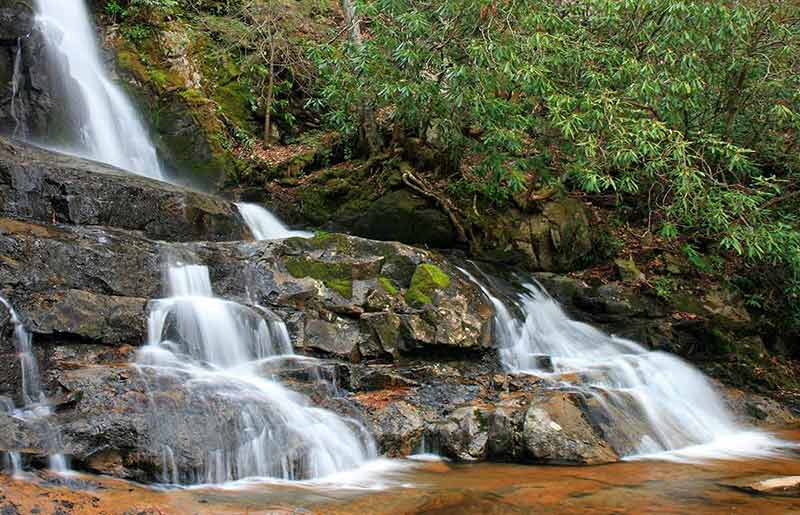
Hiking
There are 850 miles (1,370 km) of hiking trails and dirt roads in the park, including 70 miles (110 km) of the Appalachian Trail.
Hikers can enjoy breathtaking mountain views, roaring streams and waterfalls, old-growth forest groves, and historic buildings on these trails.
Fishing
Fishing, especially fly fishing, is another popular activity in this park.
The park’s waters have long been known for their healthy trout activity; brook trout are native to the area, while brown and rainbow trout were introduced.
Wildlife Viewing
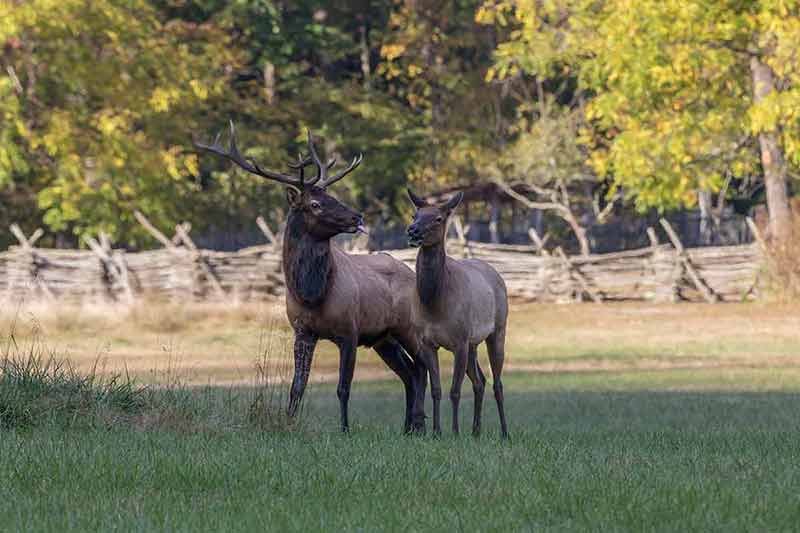
A popular place to visit in the Great Smokies is Cades Cove, a wide, lush valley surrounded by mountains that provides some of the best opportunities for animal viewing.
Animals commonly observed here include white-tailed deer around, black bears, coyotes, groundhogs, turkeys, raccoons, and skunks.
How To Get There
To visit the North Carolina side of the park, enter via Cherokee, NC, and from here, you can access the park through I-40 via US-74, US-19, and US-441.
Also read:
- 12 National Parks In North Carolina
- 21 North Carolina Landmarks
- 20 North Carolina Beaches
- 20 Things To Do In Cherokee
- 20 Things To Do In Fayetteville NC
- 20 Things To Do In Winston Salem
- 20 Things To Do In Charlotte NC
- 20 Day Trips From Charlotte
- 20 Things To Do In Raleigh NC
- 20 Things To Do In Atlantic Beach
- 20 Things To Do In Hickory NC
- 20 Things To Do In Concord
- 20 Things To Do In Cary
- 20 Things To Do In Beaufort
- 20 North Carolina State Parks
- 20 North Carolina Cities
- 20 Islands In North Carolina
- 20 Things To Do In Asheville
- 20 Things To Do In Oak Island
- 15 Things North Carolina Is Famous For
- 20 Things To Do In Duck
- 8 National Parks In South Carolina
- 20 South Carolina Landmarks
- 20 South Carolina Beaches
- 20 South Carolina Islands
- 20 South Carolina Cities
- 20 Things To Do In Florence SC
- 20 State Parks in South Carolina
- 20 Things To Do In Myrtle Beach
- 20 Things To Do In Charleston
- 20 Things To Do In Columbia SC
- 20 Things To Do In Spartanburg
- 20 Things To Do In Greenville
- 15 Things South Carolina If Famous For
2- Appalachian Trail
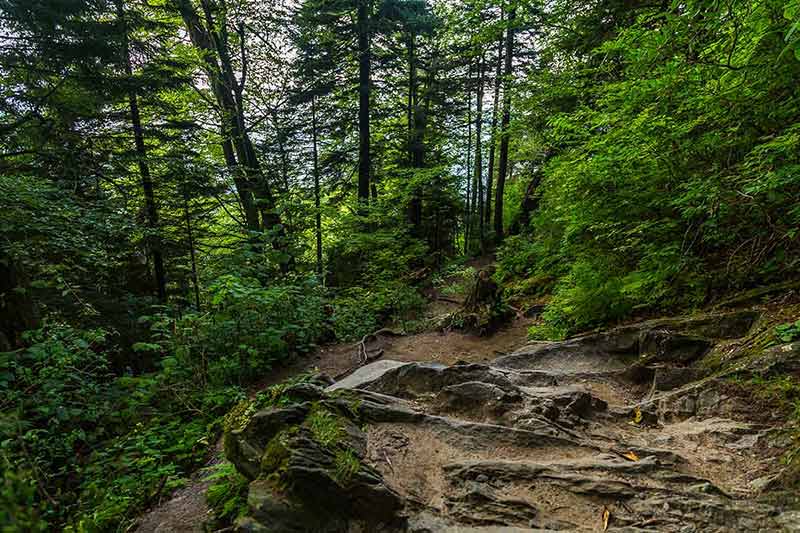
With a length of approximately 2,200 miles (3,540 km), the Appalachian Trail is a popular long-distance hiking trail known worldwide.
This famous trail connects Mount Katahdin in Maine to Springer Mountain in Georgia, traversing 14 states, including North Carolina.
The trail cuts through some of the USA’s most beautiful landscapes and provides hikers with stunning views on the East Coast.
The 95-mile stretch in North Carolina runs directly down Main Street in Hot Springs before continuing for another 225 miles (362 km) along Tennessee’s border.
Clingmans Dome, the highest mountain on the Appalachian Trail at 6,643 feet (2,025 m), is one of the breathtaking summits along this section of the trail in North Carolina.
The Appalachian Trail was established in 1921 and built by private citizens.
It was completed in 1937 and is now managed by the National Park Service, the US Forest Service, the Appalachian Trail Conservancy, multiple state agencies and thousands of volunteers.
Things To Do On The Appalachian Trail
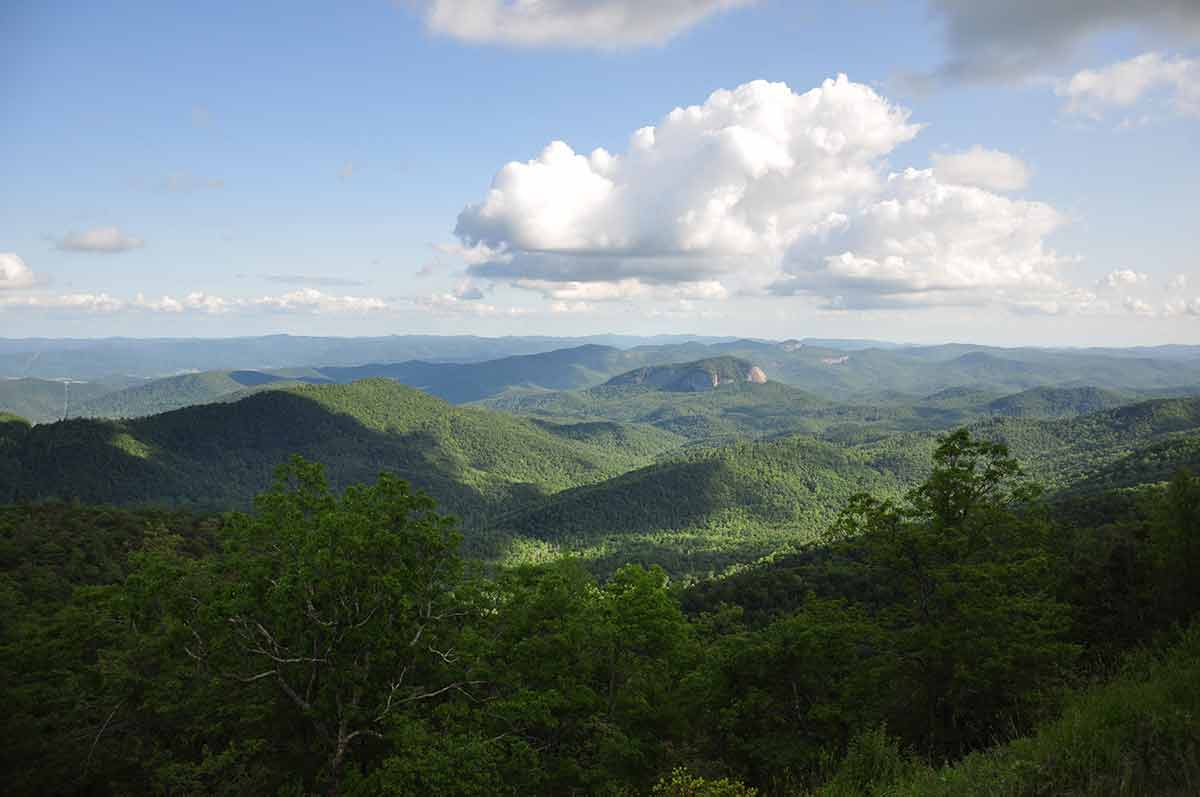
There’s a range of experiences along the Appalachian Trail. Here are the most popular hikes in North Carolina:
Lemon Gap to Max Patch Mountain Hike
This 10.5-mile (17 km) roundtrip hike begins at the Lemon Gap Trailhead on Max Patch Road and explores rivers, woodlands, and stunning fields of wildflowers as the altitude rises, providing tourists with amazing views from the high Max Patch summit.
Carvers Gap to Grassy Ridge Bald Hike
The 4.7-mile (7.5 km) roundtrip trail from Carvers Gap to Grassy Ridge traverses broad fields of grasses and wildflowers, providing visitors with breathtaking vistas for nearly the entire hike.
Carvers Gap to Roan High Knob Hike
This 4.5-mile (7.2-km) roundtrip hike begins at Carver’s Gap and winds through a beautiful woodland filled with balsam fir, fern, and moss.
The hike ascends to Roan High Knob, passes the highest Appalachian Trail shelter, and concludes at a nearby overlook with stunning summit views.
Mt Cammerer Hike
This is a 12-mile (19 km) roundtrip trail through the Great Smoky Mountains that includes a climb to Mt. Cammerer, one of the park’s most iconic peaks.
The views from this peak are breathtaking, and a historic octagonal fire tower with a wooden observation deck offers excellent views of the surrounding area.
Hot Springs to Lovers Leap Hike
This is a short but steep 2-mile (3.2-km) roundtrip hike that passes near the mountain town of Hot Springs.
The loop begins at the Nantahala Outdoor Center Trailhead.
It concludes with breathtaking views at Lovers Leap Ridge, which according to legend, was the setting for a rather sad Cherokee love story.
How To Get There
The Appalachian Trail can be reached by car, train, bus, or aeroplane from various locations.
Visitors can hike any portion of the trail from multiple trailheads or complete the entire 2,200+ mile journey.
3- Blue Ridge Parkway
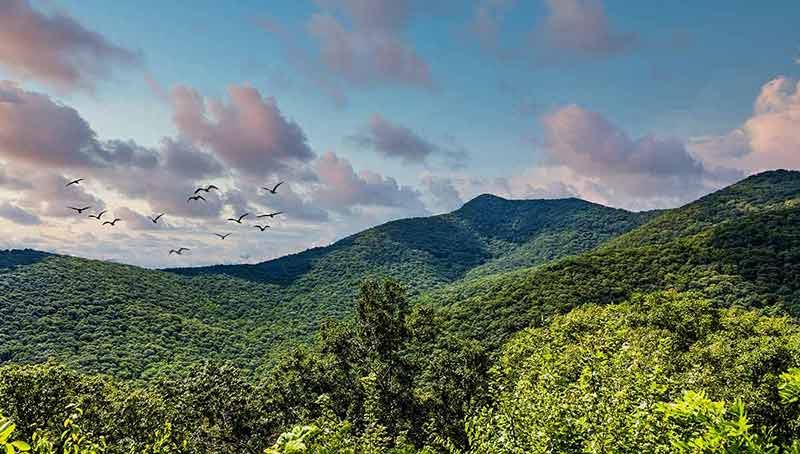
Blue Ridge Parkway connects North Carolina’s Great Smoky Mountains and Virginia’s Shenandoah National Park.
The 469-mile (755-km) national parkway is the country’s longest linear park and provides spectacular views of some of the country’s most picturesque landscapes.
It’s home to Mount Mitchell, the highest peak in the eastern part of North America.
The parkway, established in 1936, protects a wide range of plants and animals on its 93,390 acres (37.794 ha) of land.
Things To Do At Blue Ridge Parkway
Camping
The Blue Ridge Parkway has nine campgrounds open from early May to the end of October.
Every campground has potable water, comfort stations with flush toilets and sinks, picnic tables, fire rings, and RV dump stations, with a few having showers.
Enjoy Music On The Parkway
The Blue Ridge Music Center (at Milepost 213) pays homage to Blue Ridge music and musicians.
The Music Center features a free interactive exhibit titled The Roots of American Music, highlighting the historical significance of local music, an outdoor amphitheatre and an indoor interpretive theatre.
Hiking and Picnicking
There are so many trails along the Blue Ridge Parkway that it can be challenging to choose which one to explore.
There are also 14 picnic areas along the parkway and numerous overlooks with picnic tables.
Visit the Folk Art Center
At milepost 382, stop by the Folk Art Center, a museum showcasing Appalachian arts and crafts.
The Art Center, the most visited attraction on the Parkway, is the place to see unique handmade crafts.
The Eastern National bookshop and information centre are also located there, together with three galleries, a library and an auditorium.
How To Get There
The Visitor Center is at Parkway milepost 384, about a mile south of the US 70 intersection (or a mile north of the US 74-A intersection) and about 8 miles (13 km) east of Asheville.
Every mile of the parkway has a milepost marker, starting at 0 in Virginia and ending at 469 in North Carolina.
4- Cape Hatteras National Seashore
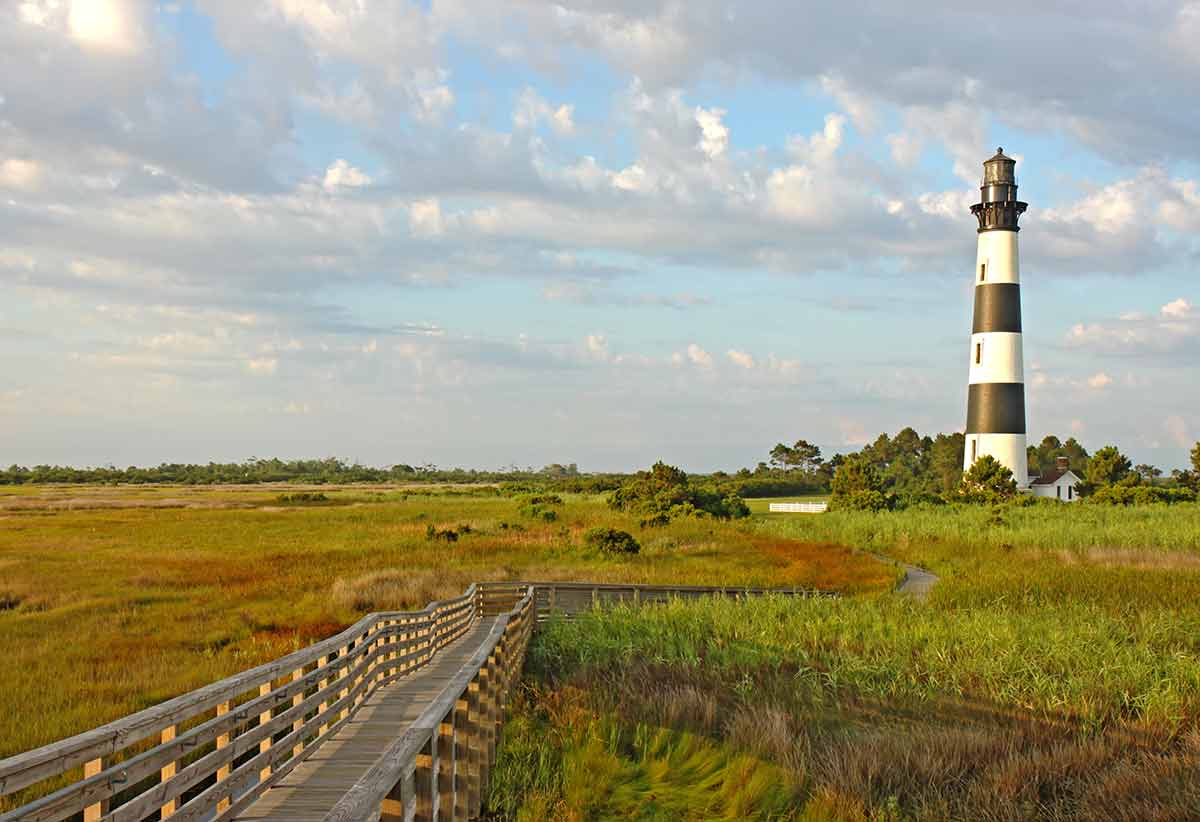
Cape Hatteras National Seashore protects parts of the Outer Banks, from Bodie Island to Ocracoke Island.
Shaped by wind and water, the islands of Cape Hatteras National Seashore are constantly changing.
The 30,351-acre (12,283-ha) National Seashore offers a home and habitat for a diverse variety of plant and animal life, from sea turtles nesting on sandy beaches to deer seeking shelter in the coastal forests.
The islands that make up the seashore also have a long and interesting history.
They have been home to Native Americans, farmers, slaves, lighthouse keepers, surfmen, and many more people who continue to influence the area’s heritage.
Things To Do In Cape Hatteras National Seashore
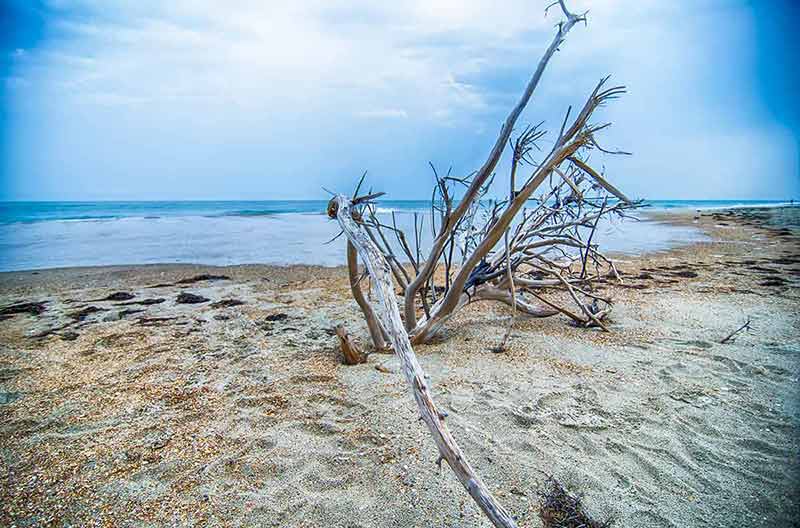
Enjoy The Beach
Take walks along the 70 miles (113 km) of beach, sit by a beach fire in the evening, fly kites in the warm sun, enjoy a picnic in the warm summer breeze.
Hunting for seashells, building sandcastles, or simply unwinding on the beach are other things to do here.
Watersports
Cape Hatteras National Seashore is an excellent location for watersports.
The activities you can engage in while on the sea are virtually endless, ranging from swimming and surfing to kayaking, canoeing, kiteboarding, and snorkelling.
Fishing
This national seashore offers some of the best fishing opportunities on the East Coast.
Although deep sea fishing is the main attraction, there are several possibilities for fishermen to fish from the surf, piers, and freshwater ponds.
Hiking
Visitors can wind their way across varied terrains and experience the barrier islands in their natural state while admiring the local flora and fauna.
For visitors who want to explore beyond the beach, there are three designated hiking trails in Cape Hatteras National Seashore: the Buxton Woods Trail, the Open Ponds Trail and the Hammock Hills Trail.
Lighthouse Climbs
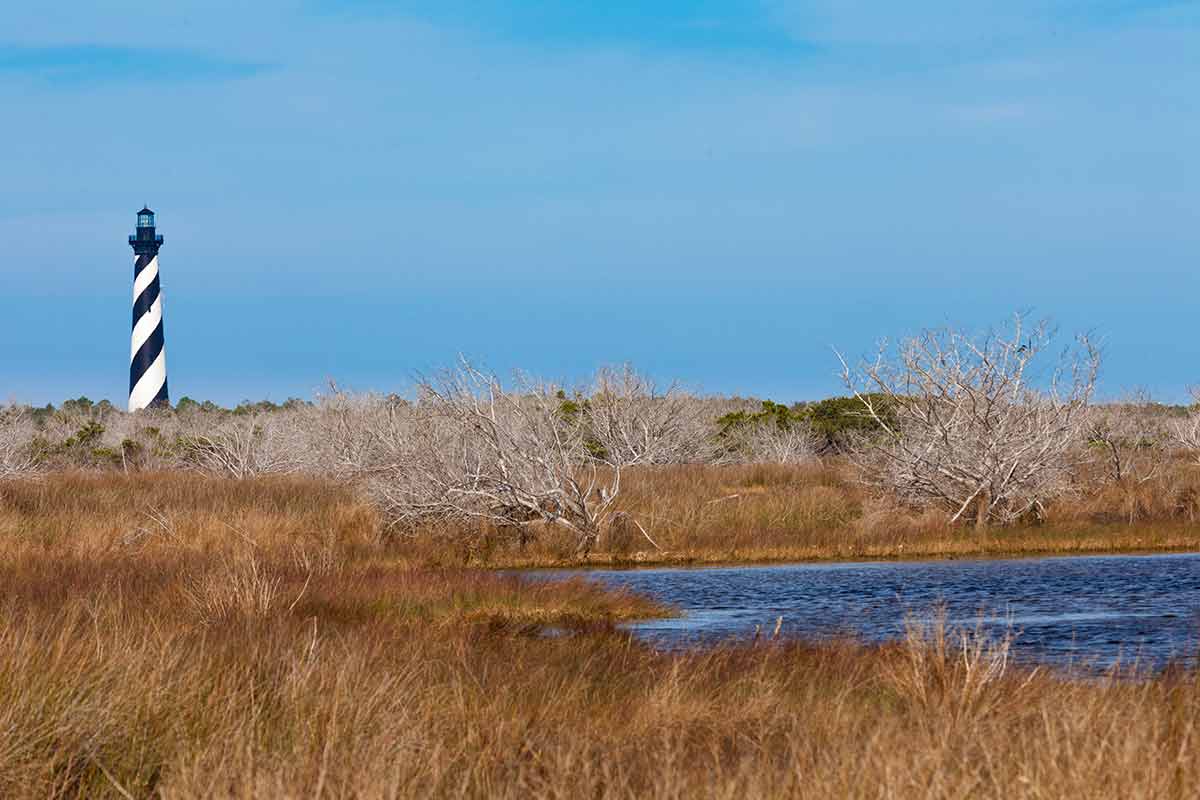
Climbing any of the three historic lighthouses in the park is a fun activity that anyone can enjoy.
Both the Bodie Island Lighthouse and the Cape Hatteras Lighthouse are available for self-guided climbs throughout the year.
The Ocracoke Island Lighthouse cannot be climbed, but its base is occasionally open for viewing.
How To Get There
Cape Hatteras National Seashore is in North Carolina’s Outer Banks.
Visitors can get to the seashore from the north by taking US 158 to Nag Heads, NC, and then taking NC-12 to Cape Hatteras National Seashore.
NCDOT ferries run from Swanquarter, NC, and Cedar Island, NC to the village of Ocracoke on Ocracoke Island.
5- Cape Lookout National Seashore
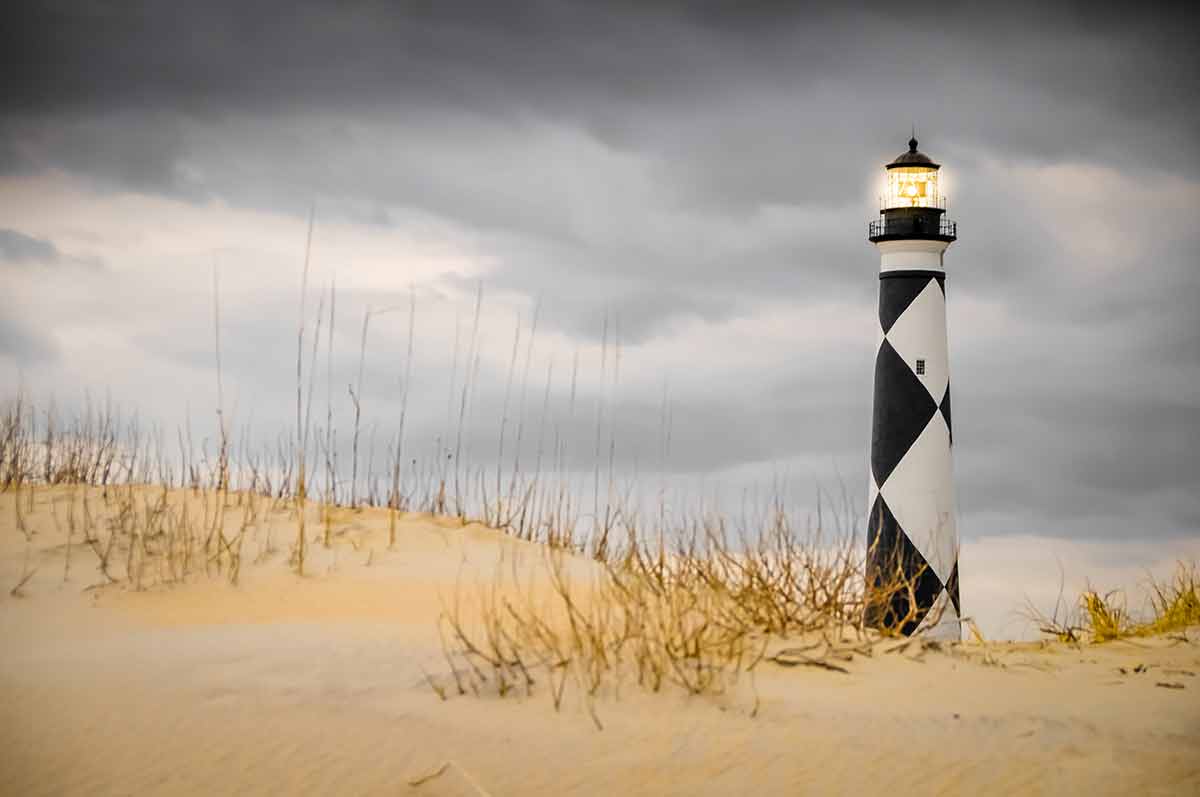
The 56-mile (90-km) Cape Lookout National Seashore protects the southernmost part of the Outer Banks of North Carolina, just east of the mainland.
The shoreline stretches from Ocracoke Inlet in the northeast to Beaufort Inlet in the southeast and consists of three barrier islands: North Core Banks, South Core Banks and Shackleford Banks.
Established in 1966, the 28,243 acres (11,430 ha) National Seashore is home to Shackleford’s wild horses, shorebirds, and two historic settlements on Core Banks.
It also features the Cape Lookout Lighthouse, which has a black-and-white diamond design.
The region has a long and fascinating human history.
Fishermen, whalers, stockmen, and witnesses to shipwrecks and dramatic rescues have all called these islands home.
It was designated as a Carolinian-South Atlantic Biosphere Reserve and a North Carolina Natural Heritage Area in 1986.
Things To Do In Cape Lookout National Seashore
Camping
There are no official campgrounds within the park, so all camping is primitive beach camping.
Visitors may camp in their vehicles, but only on the oceanside beach seaward of the main dunes, not in the middle or on top of them.
Bird Watching
Birding at the coast is a year-round activity with over 250 species to be spotted.
Summer is the best time to see terns and herons. Shorebirds, hawks, and songbirds are best seen throughout the spring and fall seasons. During winter, the most common birds are ducks and geese.
Fishing
Fishing at Cape Lookout is among the best on the Atlantic Coast in the spring and fall.
Fishing is allowed on most of the beach, but there are no boat slips or fishing piers in the park.
Stargazing
Stargazing is a favourite pastime for campers and other night visitors, as the night skies above Cape Lookout National Seashore are some of the darkest along the east coast.
This is an excellent location for viewing distant celestial objects or getting a closer look at nearby planets through a telescope.
How To Get There
Only two locations inside Cape Lookout National Seashore are accessible without a ferry: the visitor centres on Harkers Island and Beaufort, North Carolina.
6- Carl Sandburg Home National Historic Site

The Carl Sandburg Home National Historic Site (or Connemara) in Flat Rock, near Hendersonville, North Carolina, protects the home of two-time Pulitzer Prize winner Carl Sandburg.
Sandburg was also a well-known poet, biographer, lecturer, newspaper columnist and author of American fairytales.
His free verse poetry, journalism, biography, children’s stories, and social activity gave a popular voice to the American people of the 20th century.
Sandburg lived in the Midwest for a large part of his life and moved his family to this home in 1945.
This property gave him the peace and solitude he needed to write and provided his wife, Lilian, with more than 30 acres (12.1 ha) of pastureland to raise her champion dairy goats.
During his 22 years in Connemara, he continued to write and lecture, and he wrote more than a third of his works here.
The 264-acre (107-ha) property includes Carl Sandburg’s home, a dairy goat farm, rolling pastures, wooded hillside areas, five miles (8 km) of hiking paths, two small lakes, and numerous ponds, flower and vegetable gardens, and apple orchard.
Things To Do At Carl Sandburg Home National Historic Site
Tour the Sandburg Home
You can admire the furnished interior of the Sandburg Home on a guided tour and a virtual tour with 360-degree photos of the interior of the Sandburg Home.
During this tour, visitors can learn about the house and how the Sandburg family lived there.
Visit Connemara Farms
Visitors to Connemara Farms can see dairy goats descended from Mrs Sandburg’s famous herd.
Each of the three dairy goat breeds she raised — Saanen, Toggenburg, and Nubian — can be found in the herd today.
Hike the Sandburg Home Grounds
The park has five miles (8 km) of hiking trails ranging from easy to moderately difficult.
Aside from the Sandburg Home and Farm, the park’s landscape contains several other structures.
Visitors can learn more about how the Sandburg family and previous owners used these locations by following the trail of buildings.
How To Get There
The park is three miles south of Hendersonville on Little River Road, just off the Greenville Highway/Route 225 in Flat Rock, NC.
7- Fort Raleigh National Historic Site
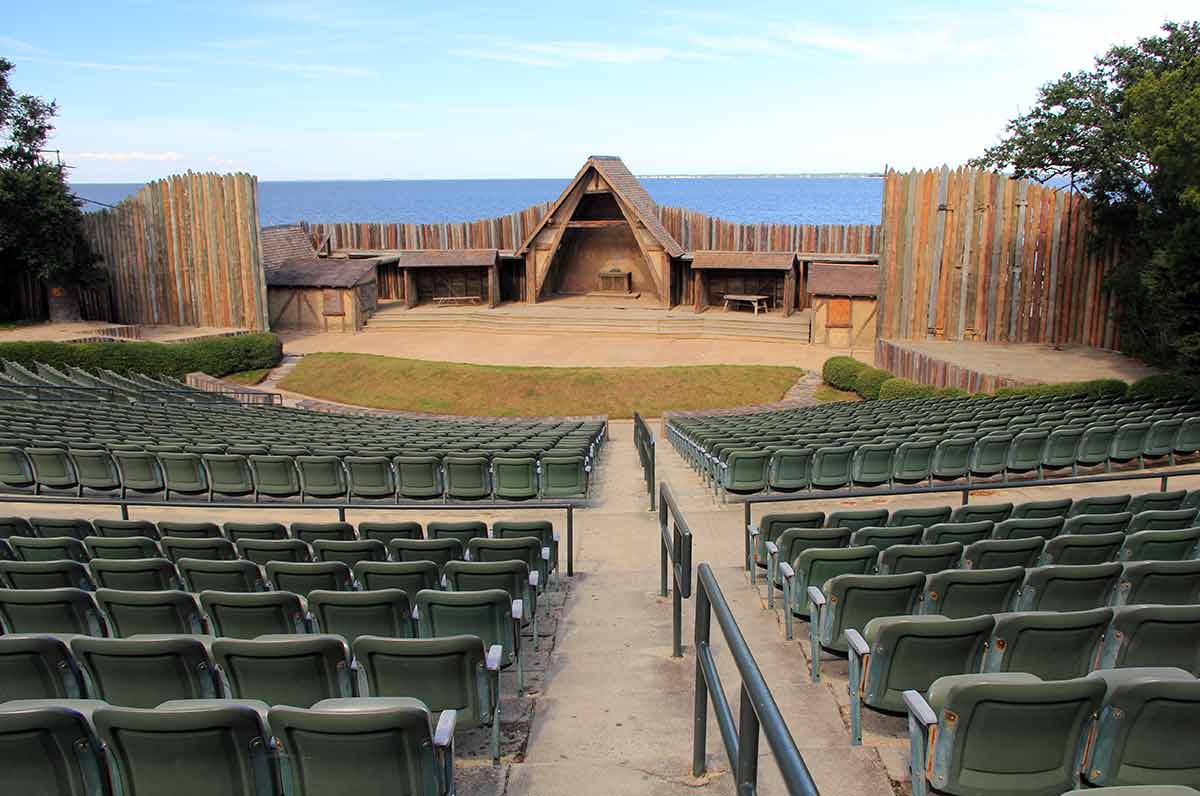
Fort Raleigh National Historic Site preserves the location of Roanoke Colony, the first English settlement in North America.
The 14-acre (5.7 ha) site also preserves the cultural heritage of the Native Americans, European Americans, and African Americans who have lived on Roanoke Island.
The colony, which Englishman Sir Walter Raleigh supported, failed between 1587 and 1590 when supply ships were late in arriving.
When next visited, the settlement was deserted, and there were no survivors.
The fate of this lost colony is one of the world’s great mysteries.
Modern academic sources, however, claim that the settlers most likely assimilated into the local indigenous tribes.
This site was also where Reginald Fessenden, one of the early radio pioneers, conducted many of his experiments.
Things To Do In Fort Raleigh National Historic Site
Visit the Elizabethan Gardens
Located within the historic site are the Elizabethan Gardens, built in the mid-20th century to honour Queen Elizabeth I.
The gardens span more than 10 acres (4.0 ha) and feature a Tudor-style gatehouse replica and over 500 varieties of expertly maintained plants.
1896 Monument
This stone monument is the first recognised memorial on the site.
The stone monument commemorates the English baptism of the local Croatoan Manteo and the birth of North America’s first English child (Virginia Dare).
First Light of Freedom
The First Light of Freedom monument is a polished black granite block with an intricate pictorial engraving that honours the Freedmen’s Colony that was established on Roanoke Island from 1863 to 1867.
The colony provided formerly enslaved people with a haven and an education to help them prepare for a new life.
Waterside Theatre
View the location of The Lost Colony, an outdoor symphonic drama.
The performance has taken place in the Waterside Theatre since 1937, with a break during World War II.
It is the first and longest-running outdoor symphonic drama in the country and is presented by the Roanoke Island Historical Association.
How To Get There
Fort Raleigh National Historic Site is off U.S. Highway 64 on the north end of Roanoke Island, North Carolina, about three miles (4.8 km) north of the town of Manteo.
8- Guilford Courthouse National Military Park

The 253.54 acres (102.60 ha) park in Greensboro, Guilford County, was established in 1917 to remember the Battle of Guilford Courthouse in 1781.
This battle was fought between Major General Nathanael Greene’s American militia and Continentals and Lord Charles Earl Cornwallis’ British and Hessian army.
This battle, which lasted for more than two hours, changed the course of the Southern Campaign of the American Revolutionary War.
The British defeat in this battle resulted in their surrender at Yorktown seven months later to a combined American and French force led by General George Washington.
Guilford Courthouse National Military Park contains 28 monuments commemorating the Battle of Guilford Courthouse, the Signers of the Declaration of Independence, local figures and the park’s founders.
Things To Do In Guilford Courthouse National Military Park
Explore the Park
Visitors can walk various paths along this battlefield to learn about the history and reflect on the significance of the events that took place here.
Visitor Center
The Visitor Center is where visitors can start their tour of the historic battlefield. Here, visitors can learn about the pivotal role the Battle of Guilford Courthouse played near the end of the Southern Campaign of the American Revolution.
Visit the Hoskins Farm
In May 1778, the third year of the Revolutionary War, Joseph and Hannah Hoskins purchased the historic 150-acre (61-ha) Hoskins Farm.
A cell phone tour explores the experience and connection of the owners, who had previously fled the war in Chester County, Pennsylvania, to the Battle of Guilford Courthouse.
How To Get There
Guilford Courthouse National Military Park is on the US 220 and New Garden Road.
Drive east on New Garden Road until you see a stone sign that says, “Guilford Courthouse National Military Park.”
9- Moores Creek National Battlefield

Moores Creek National Battlefield is an 88-acre (36-ha) battlefield park commemorating the 1776 victory of a thousand patriots over about 800 loyalists at Moore’s Creek.
In the Battle of Moores Creek Bridge, Scottish Highlanders made their final broadsword charge, and the Patriots achieved their first significant victory of the American Revolution.
The dramatic battle put an end to British plans to retake control of Brunswick Town in North Carolina for the Crown, and it had a significant impact on North Carolina becoming the first colony to vote for independence.
The battlefield park was designated a national military park in 1926 and was renamed in 1980.
Things To Do In Moores Creek National Battlefield
Moores Creek National Battlefield is ideal for visitors who want to get fit while learning about history.
There is a one-mile-long trail where visitors can enjoy a quiet walk through the 244-year-old battlefield.
You can tour the battlefield after dark, attend a living history event, or stop in the visitor centre.
How To Get There
Moores Creek National Battlefield is 20 miles (32 km) northwest of Wilmington. There are a few ways to get there, from Highway 17, Interstate 40, Interstate 95 North and Interstate 95 South.
10- Overmountain Victory National Historic Trail
The Overmountain Victory National Historic Trail is about 330 miles (531 km) long, stretching from its southern terminus in South Carolina through North Carolina, Tennessee and Virginia.
Overmountain became a National Historic Trail in 1980 and traces the paths that the patriot militia took from Virginia to the battle site at Kings Mountain National Military Park in South Carolina.
It commemorates the campaign leading to the battle of Kings Mountain, fought in 1780.
Although it’s still under development, visitors can access approximately 57 miles (92 km) of it at various points throughout the four states.
There are official sections of the trail that have been established through agreements with current landowners, and all of these sections are identified by signs with the trail’s logo.
How To Get There
The trail-marked portion in Rutherford County follows U.S. 64 west to Rutherfordton, one of only two towns through which the trail courses, and turns left on US 221 South to West Court Street.
At Washington Street, turn left and then right onto Maple Street (NC 108).
11- Trail of Tears National Historic Trail
This historic trail commemorates the survival of the American Indians who were forcibly removed from their homelands in Alabama, Georgia, North Carolina, and Tennessee and relocated to what is now Oklahoma.
The last forced removal east of the Mississippi (the relocation of more than 16,000 Cherokee Indians) was carried out by the United States government in 1838, eight years after the Indian Removal Act in 1830.
The impact on the Native Americans was devastating as they suffered from exposure, disease, and starvation. Hundreds of Cherokees died before reaching their destinations due to the relocation, and thousands more died later.
An exhibit at the Cherokee Heritage Center in Tahlequah, Oklahoma, the Cherokee Nation’s current capital, features 16,000 hand-crafted beads representing the people who endured that perilous journey.
Things To Do In Trail of Tears National Historic Trail
Hike the Trail
Visitors can walk the trail to the sacred sites, which tell the story of sorrow, intolerance, and — more importantly — the survival of the Cherokee people.
There are a variety of hiking opportunities across the entire length of the trail.
Visit the Museum of the Cherokee Indian
This museum is an interpretive facility for the Trail of Tears National Historic Trail.
Visitors can explore the several displays of artifacts as well as a gift shop, archives, and library featured within the facility.
How To Get There
Several sites are accessible along the 2,200+ mile course of the Trail of Tears National Historic Trail, which passes through 9 states.
12- Wright Brothers National Memorial
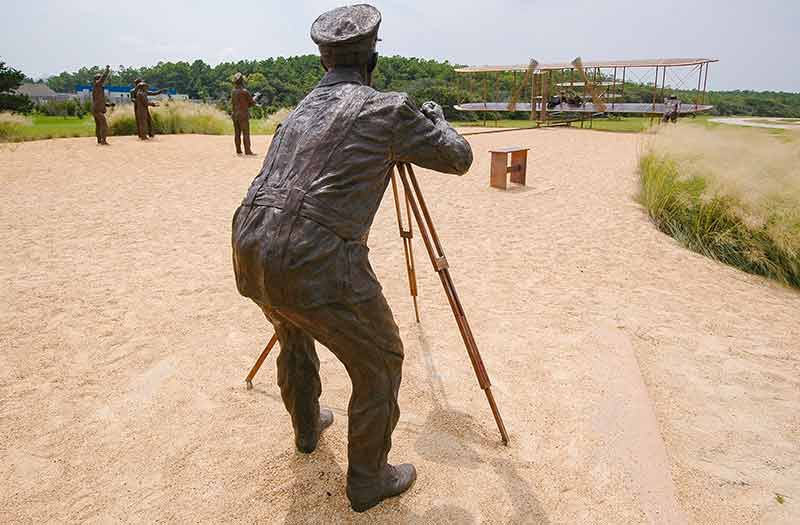
The Wright Brothers National Memorial is one of the most famous national parks in North Carolina.
Established in 1927, the 428 acres (173 ha) national memorial commemorates the first sustained, powered flights in a heavier-than-air craft.
Wilbur and Orville Wright came here from Dayton, Ohio, between 1900 and 1903, based on information from the U.S. Weather Bureau about the steady winds of the region.
They also chose this location because of the privacy it provided, as it was far from major population areas.
These self-taught engineers made the first successful aeroplane flights here on December 17, 1903, after three years of research, development and several gliding tests.
These flights were made from a level area near the base of Kill Devil Hill.
Small monuments in the park mark the starting and ending points of the four flights they made.
Things To Do In Wright Brothers National Memorial

Visit the Field and Hangar
A reconstructed hangar and living quarters, which were built on the site where Wilbur and Orville Wright stayed in the Outer Banks, give visitors a glimpse of how the Wrights camped in 1903 while conducting their groundbreaking research.
Wright Brothers Visitor Center
The museum at the visitor centre contains replicas of the tools and equipment used by the Wright brothers during their flight tests.
These include a replica of the first flight’s engine and a replica of the wind tunnel used to test wing shapes.
Other exhibits include a replica of the Wright Brothers’ 1902 glider and the 1903 Wright Flyer.
Wright Brothers Monument
The huge shifting dune now known as Kill Devil Hill served as the site of several of their glider tests.
At the top of Kill Devil Hill, which rises 90 feet (27 m), there is a 60-foot (18.29-m) granite monument commemorating the achievement of the Wright brothers.
How To Get There

The Wright Brothers National Memorial is on US Highway 158 in the town of Kill Devil Hills in North Carolina’s Outer Banks.
If you love exploring national parks, you might like to read:
- Wyoming National Parks Guide
- Nevada National Parks Guide
- Michigan National Parks Guide
- 5 Maine National Parks
- New Hampshire National Parks Guide
- 25 National Parks in Canada
- 17 National Parks in Argentina
- Tasmania National Parks
- 20 National Parks in Mexico
- 18 New Mexico National Parks
- 18 National Parks in Massachusetts
- 17 Colorado National Parks
- 4 Indiana National Parks
- 5 Nebraska National Parks
- 30 Virginia National Parks
- 9 New Jersey National Parks
- 8 National Parks in Arkansas
- 8 Alaska National Parks
- 13 Tennessee National Parks
- 6 National Parks in Louisiana
- 5 Illinois National Parks
- 7 National Parks in Oklahoma
- 7 National Parks in South Dakota
- 12 Alabama National Parks
- 5 North Dakota National Parks
- 8 National Parks in West Virginia
- 20 National Parks in Arizona
- 11 National Parks In Florida
- 8 Hawaii National Parks
- 6 National Parks In Idaho
- Texas National Parks Guide
- 9 California National Parks
- 11 National Parks In Georgia
- 7 National Parks In Missouri
- 5 National Parks in Minnesota
- 7 National Parks In Kentucky
- 8 National Parks In Montana
- 15 National Parks In Washington State
- 8 South Carolina National Parks
- 12 North Carolina National Parks
- 4 Wisconsin National Parks
- 20 National Parks In India
- 11 Oregon National Parks
- 5 Connecticut National Parks
- 27 National Parks In New York State
- 4 Iowa National Parks
- Yosemite National Park
- Zion National Park
- 21 National Parks in Pennsylvania
- 9 National Parks in Mississippi
- 5 National Parks in Rhode Island
- 9 National Parks in Taiwan
- 20 East Coast National Parks
- Guide To Winter in Yellowstone National Park
Plan Your Trip

Rent A Car – Find the best car rental rates at Discover Cars. They compare car hire companies to provide you with the best deal right now.

Find A Hotel – If you’re curious about this article and are looking for somewhere to stay, take a look at these amazing hotels.

